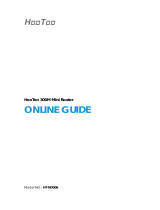
III
4.16.5 Backup & Restore........................................................................................... 95
4.16.6 Reboot
............................................................................................................ 96
4.16.7 Password
........................................................................................................ 97
4.16.8 Sy
stem Log..................................................................................................... 97
4.16.9 S
tatistics ......................................................................................................... 98
Chapter 5. Configuration—WISP
Mode ................................................................................... 100
5.1 Login
........................................................................................................................ 100
5.2 Status ....................................................................................................................... 100
5.3 Quick Setup.............................................................................................................. 101
5.4 WPS
......................................................................................................................... 101
5.5 Network .................................................................................................................... 106
5.5.1 W
AN ............................................................................................................. 106
5.5.2 MAC Clone
....................................................................................................116
5.5.3 LAN................................................................................................................117
5.6 Wireless
....................................................................................................................118
5.6.1 Wireless Settings...........................................................................................118
5.6.2 Wireless Sec
urity.......................................................................................... 122
5.6.3 Wireless MA
C Filtering ................................................................................. 125
5.6.4 Wireless Adv
anced ....................................................................................... 127
5.6.5 Wireless S
tatistics......................................................................................... 128
5.7 DHCP
....................................................................................................................... 129
5.7.1 DHCP Settings ............................................................................................. 129
5.7.2 DHCP
Clients List ......................................................................................... 130
5.7.3 Address Reserv
ation .................................................................................... 130
5.8 Forwarding
............................................................................................................... 132
5.8.1 V
irtual Servers .............................................................................................. 132
5.8.2 Port T
riggering .............................................................................................. 134
5.8.3 DMZ
.............................................................................................................. 136
5.8.4 UPnP
............................................................................................................ 136
5.9 Security
.................................................................................................................... 137
5.9.1 Basic Security............................................................................................... 138
5.9.2 Adv
anced Security........................................................................................ 139
5.9.3 Local Management
....................................................................................... 140
5.9.4 Remote Management
................................................................................... 141
5.10 Parent
al Control ....................................................................................................... 142
5.11 Acces
s Control ......................................................................................................... 145
5.11.1 Rule
.............................................................................................................. 145





















